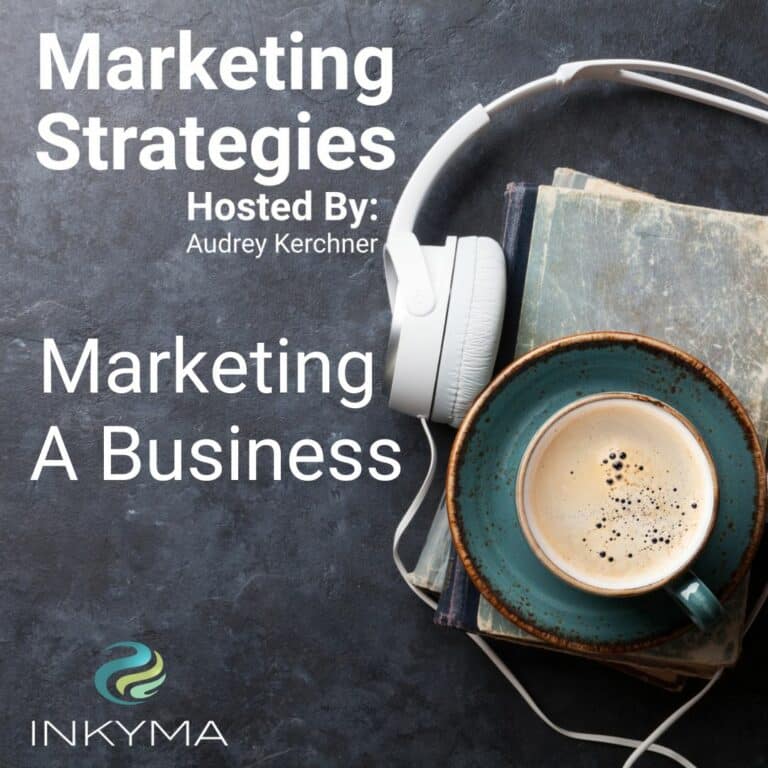Whether you have a brand new business startup or you have decided to make your hobby business your full-time business, you need Marketing for your business. A business needs to have a marketing strategy to help it grow. There is a lot of marketing available to a business but you need to have a strong foundation.
There are 4 key parts to marketing a business that we will go over in this podcast plus the Importance of Marketing:
- Branding A Business
- Website For A Business
- SEO For A Website
- Email Outreach
Links Mentioned In This Episode
Products We Recommend
Mailchimp OR Constant Contact For email marketing
Elementor For WordPress Website
RankMath For WordPress Website
Flywheel For Hosting your website
Links to Previous Episodes & articles
Episode 37- Strong Brand Identity Part 1: The Customer
Episode 38- Strong Brand Identity Part 2: How To Talk To Your Customers For Better Engagement
Episode 39 – Strong Brand Identity Part 3: Branding Visual Identity
Episode 22- A Simple SEO Strategy For Your Website
Episode 57 – Flywheel Review: Where You Host Your Website Matters
Episode 19- Email Sales Funnels For Lead Generation
Episode 46 – Drive Audience Engagement With Welcome Emails
Episode 14 – Email vs. Social Media Marketing
What we discussed:
- Importance Of Marketing
- Steps To Marketing A New Business
- Branding A Business
Marketing A Business
*Not ready to give this episode a listen or watch just yet? Below is a rough transcript of today’s episode.*
Whether you have a brand new business that you’re starting up, or you have decided to make your hobby business, your full-time business, you need marketing for your business. So today we’re gonna talk about. The top four things you need for marketing a business. Plus I’m actually gonna share with you some rough budget numbers to give you an idea of what all of this is gonna cost and what you’re gonna get for that money.
A little bit of housekeeping stuff. definitely go take a look at the show notes for this episode. in the show notes, I reference other articles, podcast episodes. There’s gonna be a rough transcript of the entire podcast in there as well. so if you feel like you need a physical document to go back and refresh yourself, it’s definitely gonna be there.
And then links to products that we’re gonna be recommending. now just a word about products that we recommend. We are partners and affiliates with many of the products that we recommend, not all of them, but a lot of them, the reason that we recommend them is because we use them. We use them for ourselves.
We use ’em for our clients and we recommend them to other business owners that we talk to day in and day out. And so when you click through. and use our link to purchase them. We do get a small feedback. So consider this as your way of, saying thank you for all this great content that we’re providing to you for free is using our links.
If you need the product, to help us keep generating all this wonderful content. Okay. So before I get into the, for,Things you need for marketing a business. Let’s talk about the importance of marketing first. Cause a lot of times when I speak to business owners, they are really not bought into why they need marketing.
And rightly so, cuz they’re brand new and they don’t understand it, but unfortunately they come to the realization way too late, um, they actually needed all of the things that I was trying to tell them that they needed. so usually they look at other brands and they go, oh, yeah, I need a logo.
And hopefully they say, oh, I need a website, but they don’t think about it much beyond that. but you do need marketing for a business in order to grow the business. And it really, it shouldn’t, and can’t be an afterthought or, oh, we’ll do that once we open. because you have it in place. When you start your growth is gonna happen so much faster.
And what’s interesting is when I talk to new business owners and they’re like, oh, I’m not getting customers. I’m not getting leads. It’s because they don’t have marketing in place. So they’re already frustrated trying to figure out what it is they need to do to get customers, to get leads, to keep customers, to kind of generate that business.
And the process is already there. Marketing is not new. There’s tons of information about marketing out there. And so start with marketing and then if the marketing’s not working, then tweak the marketing. so let’s talk about the top four things you need to do before you open your business efficiently.
So these four things, this marketing plan, this simple foundation strategy should be done during your planning phase and your setup phase, right along with hiring employees, getting your building, getting your vehicles, getting your equipment, not. so budgeting for startup is really hard, right? An established business.
We usually say spend 10% of your gross income on, marketing, ongoing marketing. And if you wanna grow, if you’re in serious growth mode, put that to 12 to 15%, but if you don’t have a year’s worth of, financial data, how do you do this? so what I like to tell brand new businesses, is set aside anywhere from 10,000 to $15,000, for marketing a business.
If you’re not gonna DIY any of it yourself, now, let’s say you don’t have 10 to 15,000. You can’t get it, or it needs to be invested in something else. We are gonna talk about how you can lower that, but I wanna do at least give you something where, you can put a financial number around it.
So now let’s talk about these, steps to marketing a new business.
So I’m talking about four foundation pieces. There’s a lot more you can do, right? If you listen to any of the other podcast episodes I have out there, or if you go to marketing masterminds or blog, you’ll see articles for all different sorts of things. But these four things have to be in place first.
They’re your foundation. and the reason I pull them into this foundation is one. You absolutely need them. And two they’re actually budget friendly for a startup. Most of them are, or. It’s something that you can DIY. And when I say budget friendly, what I mean is the one time investments. So it’s not reoccurring investments, so you don’t have to make money to pay for the marketing, or if it’s a reoccurring cost, it’s a low cost of entry.
Something that you can,maintain on your own for a while, while you’re still building your clientele. So the first one. branding a business. you need to build and create a brand. Branding is more than just a logo. it’s deciding who your target audience is. figuring out who that customer is so that you.
Decide how you want to be seen in their eyes and how you convey your values to them. Because in order to get good customers that you want, you have to know who they are, how to talk to them. and then make sure your values are aligned with theirs so that when you actually have a conversation with them, you feel like it’s a good relationship, especially if you’re a service based business because, for some service based businesses like mine, your relationships last for years for decades.
So not having aligned values. Can make you miserable. So I recommend you listen to podcast episode 37, 38 and 39. I did a whole series about strong brand identity. What goes into the brand and how you set the whole thing up. Here’s one of the few things that I don’t recommend you ever do yourself, and that is building your logo.
You can create the artwork, you can sketch it out. You can create a version of it, using something like Canva or any other type of digital design software, but don’t build the final version yourself. Not unless you know exactly how to use a, vector tool, like an Adobe illustrator, because your logo needs to scale.
For different sizes and different uses, and then they have to be interpreted differently. And if you don’t set up the digital assets the right way, you could get all sorts of weird, funky colors and fonts and all kinds of stuff across these different mediums. So what I’m talking about is your logo could be on clothing, could be on vehicles, business cards, other print materials, and digital assets.
And they’ve gotta look the same. Everywhere. Otherwise you’re gonna not look professional. You can do your own target market research and build your own customer persona, which is, a fictitious person that you talk to so that you feel like you’re talking to a real person where you’re creating marketing assets.
I actually have a template in the show note that you can use. it’s from our marketing mastermind social media program. So grab that PDF and it’s a good place for you to start. So hire a designer to do the logo, now you can either go with a single designer or you can go with an agency and really all that is gonna be price versus what you get.
Brand design or logo design is gonna be anywhere from $150 to $1,500. One time cost. You can get below one 50, but it could get very frustrating with you because, the person doing it probably doesn’t realize that you may want three or four different iterations. There’s different things that you’re gonna want, and they’re gonna,probably not respond to you the way that you need to, for a business.
So I would set your floor at one 50. Now at that lower end, they’re really gonna be just making the artwork for you. you can give them thoughts, ideas, and inspirations. That’s where your artwork could come in and then they clean it up. and then give you all the right asset files. Like the vector file.
A JPEG, a P and G. and then as the price goes higher, other things get included because then you’re hiring a branding expert and then they’re gonna help you with color choices, font choices, how things are laid out in your logo based on your target audience. And, they’ll even help you with,target market research.
So an example of this is that, we worked. and created a brand for a pet care company. they groomed, they did doggy daycare. They did kennel and, we all know how we feel about our pets. And so he was thinking his favorite color is maroon. So why not make everything maroon? And we actually told them that that’s not a good idea.
[Maroon is not a high trust color. It’s not a friendly color. And when someone is going to give you their pet child, the last thing you wanna do is have the color be a barrier. So we went with soft tones in the blues and green families. He didn’t like it, but he understood where we were coming from. And so he actually moved forward with those colors and his business is doing great because people perceive his website as easy to use friendly and fun, which is exactly what they want.
When they’re thinking about getting services for their pets. That’s what a branding expert will do for you. Just a regular graphic designer. If you say, I want this in maroon, they’ll give you four or five different shades of maroon and be on the Merry. so that’s where the pricing differences come from.
So as part of all of this, whether it’s at that 150 price tag or 1500, make sure you get a one page branding style guide sounds a little fancy, but it’s not right. Style guides can be 15 pages and all this other stuff, but what really you need are your color swatches. So you can see what the colors are supposed to look like and all the color numbers associated with it, the color numbers are needed for when you’re creating all these other, assets, right?
The people that are doing your shirts need the color numbers so that they can match threads or dyes, digitally. That is how it’s represented. if you’re having things printed, there’s different numbers for print, then there are for digital. so having all those numbers, like the hex number, which is probably the one that most of us are familiar with because a lot of online digital assets utilize our hex numbers, makes your life simpler.
And then it should also include your font names, like the names of the fonts you’re using, and then preferably a link to those fonts as well. And that’s really that all needs to be. and what this does, is it ensures brand continuity, meaning your logo should look the same. If it’s on the side of your vehicle, on your shirt or on your website, there may be slight variations, but someone looking at all of them should go, oh yeah, that’s a professional brand.
And that’s how you wanna be perceived, especially if they haven’t met you yet. Okay. So foundation piece number two. website for a business. You need a website, your website is going to be your biggest and most important marketing asset. it’s your home? It is your virtual home. So if your brick and mortar, your store is your home.
And so is your website, and it’s for everything. It tells people who you are, it tells ’em what you do. anything else that you put on the website it’s for your search engine optimization, you can’t do search engine optimization for your brand, from a social media page. It has to be done to a website it’s where you would put your blog or any other types of, communications or images.
Your products that you share. it’s for connecting. If people wanna find your telephone number or your email address or your location, they’re gonna probably check your website first. And it’s the landing page or specific landing pages for any type of outreach you’re gonna do in the future. So beyond the foundation, if you decide to do digital advertising, or if you wanna sponsor someone, or if you’re in a networking group, they’re all gonna come back to this website.
This is something you can DIY from beginning to end. for sure, because again, like I said, it is one of your biggest assets and it’s one of the most expensive. So what I would recommend here is instead of using a canned platform or a closed platform, like a square space or a Wix, or even GoDaddy, or any of those where they put the website builder inside of their hosting, we recommend using WordPress, create a WordPress website.
Because of the fact that let’s say you don’t wanna use GoDaddy anymore. Maybe you want a different host vendor. You can’t pick up a GoDaddy website at a using their website builder tool and put it someplace else. Same thing for square space or Wix they’re closed programs, right? In order for you to use them, you have to be paying them and be on their platform, but you don’t know where your brand new business is gonna be in 2, 3, 4 years.
So you need that flexibility and WordPress provides. Now with WordPress, you can buy a template where you’re filling in the blanks and switching out the pictures. And that’s totally fine if that template works for you, but if you need something more custom, let’s say what you like about the square space or the Wix is the fact that you can drag and drop and change and tweak things.
Then we recommend using element or with WordPress, which is. Gives you the ability to not have a template, but you can drag and drop and create your footers and put all sorts of things there. And it gives you the ultimate flexibility, which I think is a new business. You absolutely need, because you could build a website today and then you’re going through the process of building it and you need to add change or do something different.
The WordPress elemental platform. is gonna give you that flexibility where you can completely change things, anywhere on the site that you need to help and support your ever growing and changing business. So for hosting, because you can host a WordPress website anywhere we like flywheel, we use FlyWheel.
The things we love most about flywheel is it is a WordPress hosting company only. You can’t put anything else on there, right? No HTML sites, nothing else. And what this does is it creates a strong stable environment. And then they ensure that your WordPress software and the PHP software that it’s built on is always updated.
And then they maintain it to that. So fast, strong, stable, which is important. If your website’s down or doing waffly, things are slow. It creates a really bad experience. The other thing they’ll do is for an additional fee, they’ll actually update all your WordPress plugins, which help with your customization.
And keep you safe and secure. And they have amazing customer service. The folks there know what they’re doing. Like whenever we reach out to customer service, we always get a good answer to the problem that we have. And because we do this for a living, sometimes our issues are complicated and yet the service is just outstanding.
So budgeting for a really good website where it is built for you. Lock stock and barrel is anywhere from seven to $10,000, little bit more of a hefty price tag. But again, it is a one time cost, one time investment for your business that you can get back. and this is everything is done for you. When you start getting into those lower numbers, right?
The cheaper website, design builders, how they make up for this is they don’t do all of this for you. A lot of them will say, well, you give me all the pictures, tell me where you want them and then write all the copy and we’ll just put it all together. So basically you’re paying them to do all the fun things, which is laying out the pages, and leaving the hard stuff for you, which is deciding what picture goes, where, what the messaging should look like.
Or sound like The copy, and how all that should be. so you’re kind of DIYing it anyway, but yet you’re paying someone to put it together. Which of course, if that works for you. Great. But if you’re looking for someone to do everything, then that’s your price range. So in tandem or the next thing directly after this, or towards the end of the project is SEL for a website.
You need the search engine optimization, built into the website, and it’s really done during. And then of course, after I talk about the top things that you need to focus on for search engine optimization in episode 22. So go take a listen to that ongoing SEO, For this to happen, you need a blog, right?
You need a content strategy. but SEO is so important that writing blog articles or getting someone to write blog articles for you is really important. It’s free, right? Google optimizes, your content and serves it up and they don’t charge you. And they’re really good at it. It does take time, right?
For a single article or for a site to really get ramped up. You need six months to a year and you gotta be consistent about your posting, but the impact that it has for the effort that you’re putting into it. or what I like to call the ROI is outstanding. So you write an article today and it can,feed your search engine optimization for the lifetime of your site, depending on what’s going on in the world.
So let me give you an example. We have a client, they do in-home senior care, for the elderly. And so a couple years before the pandemic. We wrote a series of three articles about video conferencing with seniors to combat loneliness and staying connected and all of those good things. And it did outstanding after it got optimized in those first couple years.
During the pandemic, it went nuts, right? It was their top content. they still show up on page one. When you, look for video conferencing with seniors, but they’ve gotten so much traffic so much free traffic from that, which then turns into leads because of the way that the website is built.
So they’re not paying for digital advertising for those they’re not paying for anything else. and the articles are five or six years old now, and yet they’re still one of the top, pages that people land on when they come to the site. . So if you go the WordPress route that we talked about, you can get a plugin tool called rank math.
Did a whole episode about how awesome rank math is because I like it. Another one you hear about out there is Yost. We used to use Yost and then we switched to rank math. and what it does is it helps you optimize your blog content. And so you put an article in and it gives you a score and then it tells you what the things you need to do to improve that score on that particular article.
So that if all of your articles in the green, you know, that you have optimized your content as much as you possibly can in order for them to rank high in. so blog writing is the heart of SEO. And so to get blog writing, and then make sure that you get the, search engine optimization with it. It’s gonna cost you between six 50 and a thousand per month, cuz you’re getting articles written and there’s a lot that goes on.
You can have someone else write the articles and you optimize them using your rank math tool and your website just be prepared. You might have to tweak the content a bit, but you can give the blog writer guidance. Once you get into the rhythm of, using rank math, tell ’em, this is my keyword phrase for this.
And then make sure you use it here, here, here, and here, so that you don’t have to go back and redo that all the time. But that’s gonna take you a little bit time, but again, it’s gonna save you some money as part of this process.
And the last foundation piece is email outreach. You need to do some sort of outreach, right? Search engine optimization. You put it out there and Google pushes people to you, but you have to have a way to get out to people when they’re not looking specifically for you at that moment in time. And email is the most cost effective, easiest way to do.
People get to see your brand. You get to pull them back to your website. One of the simplest things to do, especially if you’re doing the blog writing for search engine optimization is you can also send those blog articles out in a newsletter every month. that way that content is doing double duty, it’s doing the push pull at the same time.
But there’s other things that you can do as well, is you can do sales funnels and you can do welcome newsletters. Because pretty much everybody has an email, so you can send it to existing customers. You can send it to leads, to stay top of mind. You can get people to sign up for the content so you can keep getting into their inbox.
So for different ideas on the types of emails you can send, listen to episodes. 46 and 19, just to give you a couple of different ideas. the tools that we use that we’re certified partners in, are MailChimp and constant contact. We like them both. some have. Certain features that are better for certain types of customers than others.
They integrate with pretty much everything out there, not just WordPress, but if you’re a retailer and you have a Shopify site, MailChimp integrates beautifully with Shopify and the content. so it’s gonna scale and grow with your business to start out with, depending on your list size, you’re gonna spend 20 to $50 per month, depending on the feature set, you can get up into the hundreds per month, but that’s after you’re like got a lot of emails.
You need a lot of features. So you’re out of, startup mode by that point, cuz you probably have a lot of clients. , this is something you can absolutely set up yourself. They are very user friendly tools, even designing the emails, they have beautiful templates where you just pop your colors and your brand in, or you can hire a partner to do it for you.
I recommend a certified partner in either of those platforms, right? Because part of the certification process is you have to prove that you know how to use the tool and all of the features associated with it. so they’ve gotten an in depth, background. Okay. So those are the four foundations. Wait, I hear you.
I hear you out there saying, what about social media? Why isn’t that a foundation? So I purposefully didn’t put social media in my top foundation pieces, because of the fact that. , it’s not an asset you own. If you look back on the list, I’ve created your brand, your website, search engine optimization, the email outreach, that’s all content you own and control you.
Can’t control what Facebook, TikTok or LinkedIn is gonna do any day of the week, who they’re gonna show your content to. You have very limited. design control as well. Even with email marketing, your template, you can build a template from scratch and make it look any way you want. And MailChimp is still gonna send that email to your entire audience.
They’re not gonna throttle it back and only show it to 1% of your audience. If you’ve got 300 people in your audience that email’s going to 300 people, the only way it’s not gonna reach ’em is if it bounces because the email address is. and so that’s why I don’t consider social media foundation. Yes.
It’s useful. It’s necessary. It’s probably something you should do. at some point, but it’s after all of these assets are working and in place first, because most brand new business owners, they wanna do the bare minimum to get their business up and running and so that they can start making money. So now that you have a better understanding about.
The marketing foundation pieces for marketing a business. Let’s talk about your next steps, your action steps. So the first thing I want you to do is based off of this, determine where you are with your business. you may be listening to this and you’re like, I haven’t done anything. This is great.
But more than likely you probably dabbled in a little couple of these pieces, you created a Facebook page. Maybe you made a logo or maybe you just did a business card, but not a logo. so you gotta figure outout of all this what’s missing, then the next thing you need to do is fill in the gaps of your foundation.
These are all foundation pieces. I spoke to you about them in the order of their importance and how they should be done. Branding has to be done first. You can probably get away with running website, search engine and email in parallel. Gonna be a little tricky. but you gotta have the brand first cuz your logo and how you talk to people and what you say and your keywords are all part of what you need for all those other pieces.
So because these are in order of how they’re done, that’s the order you should use to fill in your gaps. Meaning if you have gaps in all four areas, start with filling the gaps in your brand. First, you might have a logo, but maybe you don’t have your target. Fill out your target audience, get your customer persona, figure out your language, then move on to filling the gaps in your website, your SEO, and then finally your email outreach. So here are my final thoughts for you. Decide if you want to DIY. This do it yourself. Or if you wanna hire an expert, like I said, aside from the logo, all of this, you can do yourself. I just wanna make sure you do it the right way, use the right tools. we gave you a bunch of recommendations, costs associated to them.
And then, it just takes time. many startup business owners. They have more time than they have money. And that’s totally okay. Just make sure you invest in your education. Utilize the resources we give you. income is marketing strategy podcast. You can go through the whole list. There’s a ton of other episodes out there that are gonna help you with these foundation pieces.
And so will marketing masterminds the blog. so let’s say you don’t wanna do it yourself. Maybe you’ve got that budget we discussed and you wanna hire partners hire the right partner or partners. Use the information from this podcast, from the blogs, from the other podcast to make sure you’re hiring people that align with your thought process.
If in your mind, you’ve decided. Yeah, I like the idea of a WordPress website using Elementor on a flywheel hosting platform. Make sure you get someone who. Experience in that and that they’re not WICS experts, cuz then they’re gonna try to drive you towards Ws and then you’re not gonna have a great experience or the most easy thing you could do.
And I’m being cheeky here, is you could just hire us. So here at Inma, we love to give back to the business community. We do it in a bunch of different ways. we provide a 45 minute consultation. You can schedule that on our website. Just go to inma.com. I K yma.com. the podcast is hosted there as well as there is a schedule, a marketing evaluation button in the right hand corner.
Just pick your date and time. And we are on the calendar on the website. There’s a contact form. Maybe it’s a quick question. Or you have a thought to share with me or a suggestion for a show, which I love you can go there and do that. we have marketing masterminds. It is our educational blog that is marketing masterminds.co, just no M at the end.
And we have articles there. You can sign up for the newsletter. And of course we have our podcast here where we’re sharing,All of this good information with you. So hopefully you found this episode’s information helpful. If you know other business owners that are trying to market their business the right way, please share this content, share all the content that we share with you, because our goal here is to help all businesses grow and thrive in the industries that they’re in.
Thanks so much and have an amazing day.



























